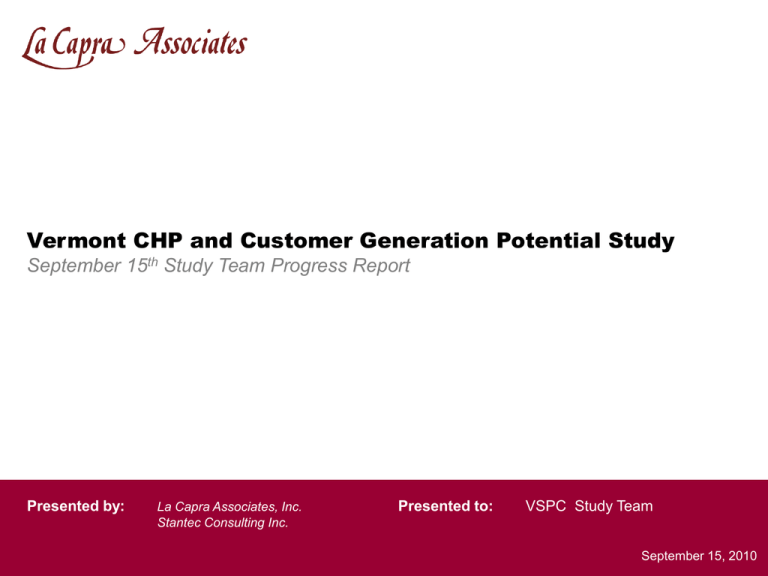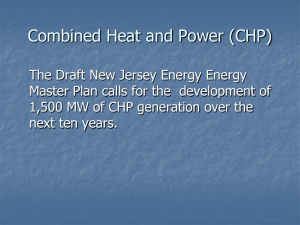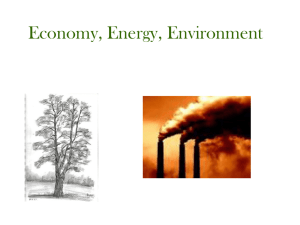Sept 15 Progress Review Handout
advertisement

Block Island Vermont CHP and Customer Generation Potential Study September 15th Study Team Progress Report Presented by: La Capra Associates, Inc. Stantec Consulting Inc. Presented to: VSPC Study Team September 15, 2010 Agenda Objectives for today’s briefing Existing CHP/Customer Generation CHP Technology Overview CHP Potential Methodology - Assumptions and Economic Testing John Athas Summary of Issues from Discussion Patty Richards Next Steps John Athas Dan Kelly, Jose Donnell Dan Kelly John Athas, Patty Richards, Barbara Stoddard, Melissa Whitten Patty Richards, John Athas 2 Objectives for today’s briefing 1. Provide an Update of the current CHP / Customer Generation Investigations 2. Provide an Update on the CHP Potential including an understanding of: Methodologies and approximations Progress in Data Gathering 3. Discuss any study issues and obstacles with the VSPC Study Committee – Sub-bullet 3 Existing CHP/Customer Generation Data Gathering Industrial Database review Vermont Utility Survey by La Capra Team VT PSB • Net-metering applications • Posted CHP Existing Facilities Host Customer Electric Load Information Request? Mapping of Locations Summaries of Technology and Operations Customer Phone Interviews Economic Review 4 Existing CHP/Customer Generation – Preliminary Tabulation PLANT_NAME PHYS_CITY COUNTY Brattleboro Kiln Dry Company Ethan Allen, Inc. Bellow Falls High School Crescent Manor Nursing Home Berkshire Cow Power Brattleboro Retreat Omega Optical Blue Spruce Farm Vermont Energy Investment Corporation Hinsdale Farms East Ryegate Wood Energy Pompanoosuc Mills Essex Junction Wastewater Treatment Florence Project Gilman Mill Bell Gates Lumber Middlebury College Foster Brothers Farm, Inc. North Country Hospital Norwich University Green Mountain College Biomass Facilitiy Westminster Farms Green Mountain Dairy Farm Rock Tenn South Burlington School Southern State Correctional Facility Montagne Dairy Farm Green Mountain Coffee Roasters Battleboro Beecher Falls Below Falls Bennington Berkshire Brattleboro Brattleboro Bridport Burlington Charlotte East Ryegate East Thetford Essex Junction Florence Gilman Jeffersonville Middlebury Middlebury Newport Northfield Poultney Putney Sheldon Sheldon Springs South Burlington Springfield Swanton Waterbury Windham Essex Windham Bennington Franklin Windham Windham Addison Chittenden Chittenden Caledonia Orange Chittenden Rutland Caledonia Lamoille Addison Addison Orleans Washington Rutland Windham Franklin Franklin Chittenden Windsor Franklin Washington ZONE_VEL CO IND_DESC O A O O P O O J G I E K B,I L F C J J A E M O B,C B,C G N B,P E Wood Products Furniture Schools Nursing Homes Agriculture Misc. Education Instruments Agriculture Office Buildings Agriculture Pulp and Paper Furniture Wastewater Treatment Minerals Pulp and Paper Wood Products Colleges/Univ. Agriculture Hospitals/Healthcare Colleges/Univ. Colleges/Univ. Agriculture Agriculture Pulp and Paper Schools Justice/ Public Order Agriculture Food Processing START FUEL_TYP PRIME_MVR E1 GEN (kW) 2000 ERENG 1940 B/ST 1991 ERENG 1996 ERENG 2006 ERENG 1988 ERENG 2005 ERENG 2005 ERENG 1988 ERENG 2005 ERENG 1992 B/ST 2008 B/ST 2004 MT 1992 CT 1982 B/ST 1988 B/ST 1982 B/ST 1982 ERENG 2005 B/ST 1987 B/ST 2010 B/ST 2009 ERENG 2007 ERENG 1994 B/ST 1999 ERENG 2005 ERENG 2007 ERENG 2003 ERENG NG WOOD OIL NG BIOMASS OIL OTR BIOMASS NG BIOMASS WOOD WAST BIOMASS NG WOOD WOOD OIL BIOMASS WOOD OIL WOOD BIOMASS BIOMASS OTR NG NG BIOMASS NG 380 1,232 433 60 600 1,000 461 392 60 65 20,000 30 60 7,600 4,000 75 1,885 142 274 625 300 225 275 1,135 60 600 300 375 CHP YES NO YES YES YES YES YES YES YES YES NO YES YES NO NO YES NO YES YES YES YES YES YES NO YES YES YES YES 5 CHP Technology Overview Prime Mover Technologies to be Studied Internal Combustion Turbine Diesel Based Configurations Fuel Cells Combustion Turbine Steam Turbine / Back Pressure Steam Turbine Key assumptions being finalized Available Sizes and Fuel Electric and overall thermal efficiencies Cost & Performance 6 CHP Potential Methodology Overview of analysis Customer / Segment Characteristics Segment Size Electric Load Thermal Load Natural Gas Availability CHP / Customer Generation Equipment Operation 7 CHP Potential Methodology - Overview Begins with estimation of Customer segment sizes represented by a typical customer SIC Code – two digit Load Zone Fuel availability Electric and Thermal Use Characteristics, potential for CHP and Electric to Thermal Switching such as Absorption Chilling Various Generation technologies and sizes tested for each segment. Analysis approximates the operation of a CHP unit based upon electric and thermal match Lowest cost per kWh plant will be chosen 8 CHP Potential Methodology – Electric Load Data MWH by Zone Statewide - EVT Data Burlington - BED Data Retail Sales (no distribution, transmission or sub-transmission losses) Missing IBM 2008 and 2009 data set – Used average 2005 to 2007 for missing IBM data Missing ~ 8% of the load data from the zone counts. – Per EVT missing data : » OMYA » Stowe Mount Mansfield Load » Unknown Loads » Will make adjustment to load zones per above 9 CHP Potential Methodology – Electric Load Data Customer Count by Zone SIC MWH by Zone by SIC Number of Customers by Zone by SIC No KW… yet (EVT) If no data produced may need “typical load” factor Will have to back into KW 10 CHP Potential Methodology - Sample Customer Data Number Customers per Load Zone per Type (C= Commerical, I=Industrial, R= Residential) Sum of CountOfUPremise LoadZone A B C D E F G H I J K M N O P Grand Total ZoneDescription Newport St. Albans Johnson Morrisville Montpelier St. Johnsbury Burlington IBM Chittenden\Addison GMP Middlebury Central - Barnard Rutland Ascutney Southern Highgate Sector C 1,980 2,236 1,098 2,538 5,182 1,938 3,722 7,220 1,499 4,699 5,938 1,830 7,179 1,263 48,322 I 4 6 4 9 2 13 1 11 3 4 9 2 14 1 83 R Grand Total 14,640 16,624 17,744 19,986 11,007 12,109 11,262 13,800 33,815 39,006 11,412 13,352 16,293 20,028 1 41,980 49,211 9,027 10,529 28,436 33,139 36,266 42,213 12,300 14,132 45,515 52,708 10,111 11,375 299,808 348,213 11 CHP Potential Methodology – Sample Load Zone Data Sales KWH Average (2007 through 2009) Sum of KWH (Avg '07-'09) LoadZone A B C D E F G H I J K M N O P Unknown Grand Total Sector Zone Commercial Industrial Residential Unknown Grand Total Newport 69,659,778 30,866,073 83,614,924 184,140,775 St. Albans 103,448,666 84,367,278 136,617,733 324,433,677 Johnson 31,920,910 52,837,304 78,019,063 162,777,277 Morrisville 75,106,752 73,593,970 148,700,722 Montpelier 196,122,954 74,853,804 225,812,447 496,789,204 St. Johnsbury 73,957,128 22,938,649 75,903,868 172,799,645 Burlington 215,256,667 49,632,000 88,089,333 352,978,000 IBM 225,431,785 225,431,785 Chittenden\Addison GMP 436,347,593 85,216,134 312,905,919 834,469,646 Middlebury 60,622,871 48,355,935 72,955,409 181,934,215 Central - Barnard 148,893,221 36,991,422 202,185,166 388,069,809 Rutland 227,723,347 97,049,549 260,818,338 585,591,233 Ascutney 71,284,266 11,059,939 86,981,782 169,325,987 Southern 305,780,389 135,891,646 324,318,285 765,990,320 Highgate 51,398,438 55,529,543 66,950,910 173,878,891 Vermont 103,537,847 103,537,847 2,067,522,979 1,011,021,060 2,088,767,147 103,537,847 5,270,849,033 Statewide Avg Delta Missing - OMYA - Mount Mansfield - Unknown Accounts 5,696,793,053 460,456,636 8% Action Zone Assign to L Assign to D load weight avg all zones 12 CHP Potential Methodology: Estimated Thermal Load How to obtain Thermal Load – Load not served by electricity Sources for natural gas usage by Industry may exist: Vermont Natural Gas: – Service territory does not include entire state – Availability: to be determined Need total thermal load served by all fuels not just gas Input-Output data collected annually by SIC code – Annual tables have limited detail – Benchmark years have more detail but released with a lag – latest year is 2002 – Provides metric for electric, gas, coal, and petroleum used to produce each industry’s output. 13 CHP Potential Methodology: Estimated Thermal Load Input – Output Table: Bureau of Economic Analysis (BEA) Provides value of fuel used as a share of output Correspondence to 4-digit SIC code level detail (*) Paper Mills (SIC 26): for every $1.00 of output produced: – Electricity: 3 cents Natural Gas: 2.7 cents Algorithm to Estimate Electric to Total Thermal Load: Relative fuel prices to electric prices for Benchmark Year 2002 Developed algorithm to estimate Electric to Total Thermal Load Combined ratio of each fuel’s share of output to electricity’s value – in algebraically correct manner * Fuel price ($/ mmBtu ) divided by Electricity price ($/mmBtu) Apply to EVT, et al, kWh by SIC to obtain Thermal Load for use as input to Customer Economic Model. 14 Historical Price by Fuel Type: create price ratios EIA Electric Power Annual - State Historical Tables for 2008 Released: January 21, 2010 Average Price of Electricity by Provider, 1990-2008 Year State Industry Sector Category 2002 US-TOTAL Total Electric Industry - Cents per k Wh 8.44 7.89 4.88 6.75 7.20 $ per MWhr 84.40 78.90 48.80 67.50 72.00 $ per MMBtu 24.73 23.12 14.30 19.78 21.10 Source: http://www.eia.gov/dnav/ng/ng_pri_sum_dcu_nus_a.htm (Note: Thousand Cubic Feet = Mcf) 2002 U.S. Residential Commercial Other (street lighting, agricultural & irrigation, transporation) Industrial U.S. Price of Natural Gas Delivered to Sector (Dollars per Mcf) Residential Commercial Industrial Electric Power U.S. Natural Gas Prices $/Mcf 7.89 6.63 4.02 3.68 mmBtu/Mcf 1.03 1.03 1.03 1.03 $/MMBtu 8.10 6.81 4.13 3.78 Source: EIA AEO 2005, Reference Case Forecast Table A3. Energy Prices by Sector and Source, and Table A19. GDP Price Deflator Index 2002 U.S. Petroleum Products (Wgtd Average) 2002 U.S. Steam Coal 2002 U.S. GDP Deflator Ratio of Electric / Gas Price $/MMBtu Total Price All Users 0.00 U.S. Price of Fuel Delivered to Sector (Dollars per MMBtu) Residential Commercial 9.86 0.98 3.05 Industrial 6.83 0.98 3.40 Electric Power All Users 6.41 4.29 8.93 1.57 1.25 1.27 0.98 0.98 0.98 3.46 3.78 2.36 Ratio of Electric / Petroleum Price $/MMBtu 2.23 3.33 16.65 Ratio of Electric / Coal Price $/MMBtu 9.10 11.46 16.65 15 Example: Thermal Load Estimation for one SIC U.S. BUREAU OF ECONOMIC ANALYSIS (BEA) INPUT-OUTPUT (I-O) ACCOUNTS 2002 BENCHMARK YEAR (Detailed SIC Code Data) TABLE: Commodity-by-Industry Direct Requirements, after Redefinitions (1987, 1992, 1997 to 2008) EVT / La Capra / BEA SIC Concordance (NAICS) IOCode 26 322120 INPUT / OUTPUT: Each Industry Uses these Sources of Energy as a Commodity INPUT. The values shown represent the cost of that INPUT as a share of $1.00 of each industry's OUTPUT. 212100 Coal mining 221100 Electric power gen, transm, distr 221200 Natural gas distribution 324110 Petroleum refineries Industry Name (NAICS Description) Paper mills Electric / Other Fuel Input as a share of Total Output: 0.0028467 0.0309194 0.0266901 0.0084476 10.86 1.16 3.66 Electric Price / Other Fuel Price - Industrial Sector: 9.10 3.46 2.23 Fuel Prices $/MMBtu 1.57 4.13 6.41 0.33 1.64 Interim Step Estimated Electric to Total Thermal Load: 14.30 1.19 0.23 EVT & Segments kWh (converted to Btus) / Estimated Electric to Total Thermal Load = Thermal Load Btus Used as Input to Economic Analysis 16 CHP Potential Methodology: CHP Operation Customer Segment Characteristics Electric Peak Demand Estimation Split of High Quality (e.g. Steam) and Low Quality (e.g. Hot Water) Thermal Usage Capture Existing Fuels used for Thermal Energy Production Allowance for Thermal Use Characteristics Thermal Match Factor (reduces customer thermal) Thermal Requirement Split (reduces hours of CHP operation) CHP Unit Assumptions Sizes Evaluated – Max Customer Peak, Minimum based on Load factor Units Operate whenever Thermal output is utilized on-site Excess sold at Market Prices to grid 17 CHP Potential Methodology: Potential Definitions Technical Potential Generation Plant Sized ‘optimally’ for each segment Customer Thermal Load dependent Will not include creation of aggregated thermal loops such as district heating and cooling Segment CHP Cost of Electricity Net Cost of Electricity for the “Technical Potential” Blocks Economic Potential Sizes Evaluated – Max Customer Peak, Minimum based on Load factor Units Operate whenever Thermal output is utilized on-site Excess sold at Market Prices to grid 18 Assumptions and Economic Testing Assumptions EVT Assumptions Cost of Money Discount rate Avoided Costs Escalation Rates ‘Core’ Fuel Price Externality ‘costs’ of emissions Electric Utility Rates – specific local utility 19 Assumptions and Economic Testing Economic Testing Net Cost of Electricity Host Customer Economics – value based upon electric rates and market prices 20 year NPV, Simple Payback, Internal Rate of Return Electric Utility Resource Economics – value based on market prices for energy and capacity, avoided distribution and transmission Societal Test, Total Resource Cost Test, Utility Cost Test 20 Economic Testing – Net Cost of Electricity CHP Fuel Thermal Credit Net Cost of Electricity O&M Capital 21 Summary of Issues from Discussion Existing CHP Customer Data Methodology 22 Next Steps 23 Thank you Contact Information: One Washington Mall, 9th Floor Boston, MA 02108 www.lacapra.com 617-778-5515 277 Blair Park Suite 210 Williston, VT 05495 802-861-1617 or 802-861-1618 John Athas jathas@lacapra.com 24









